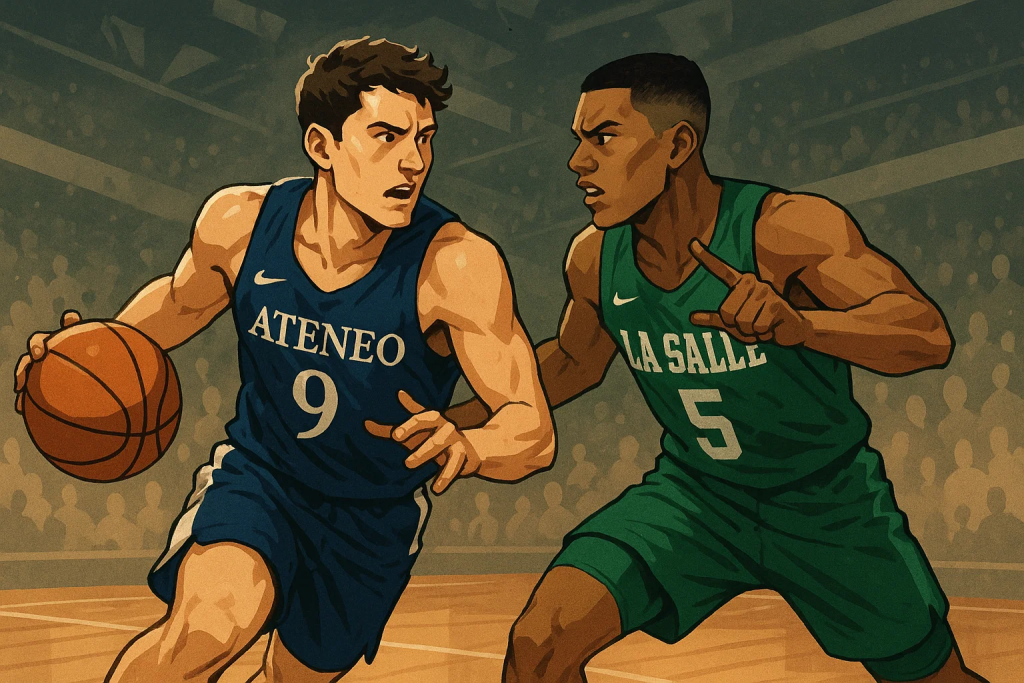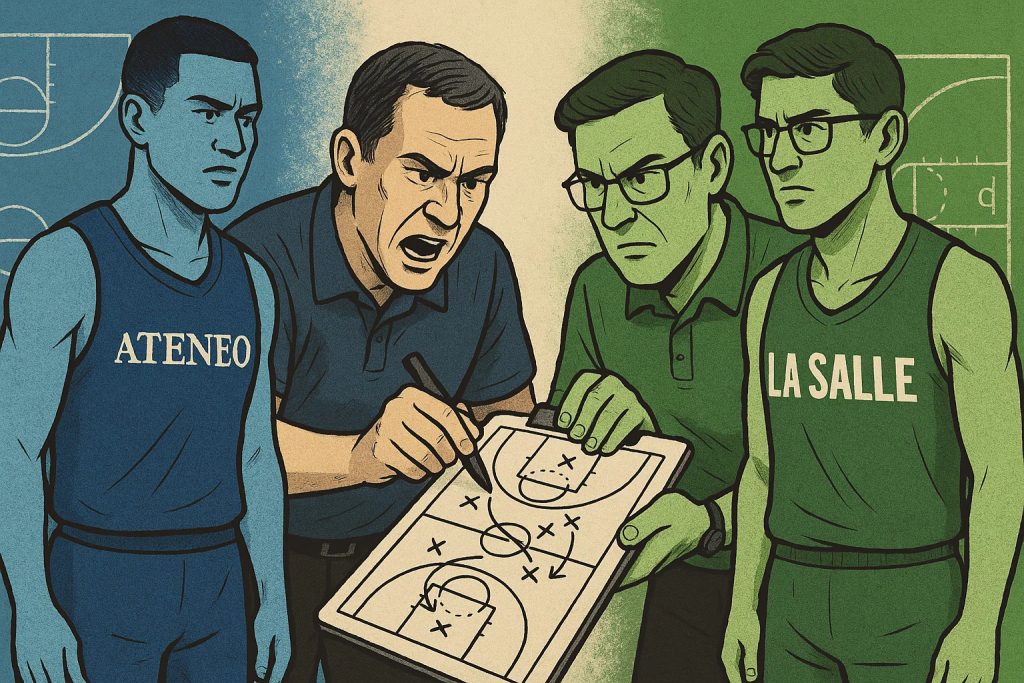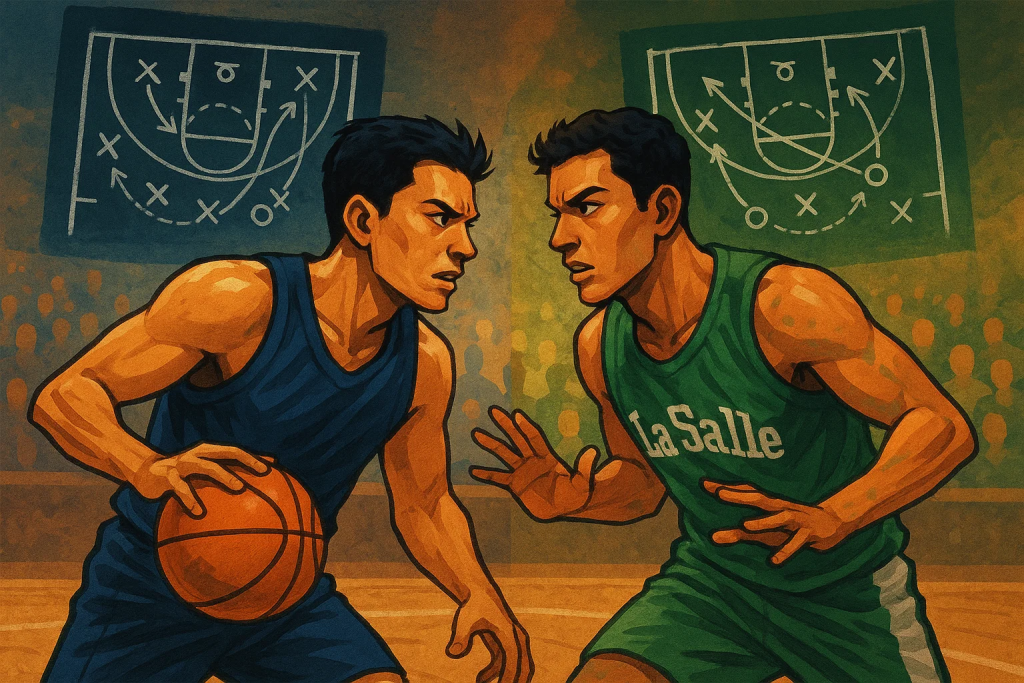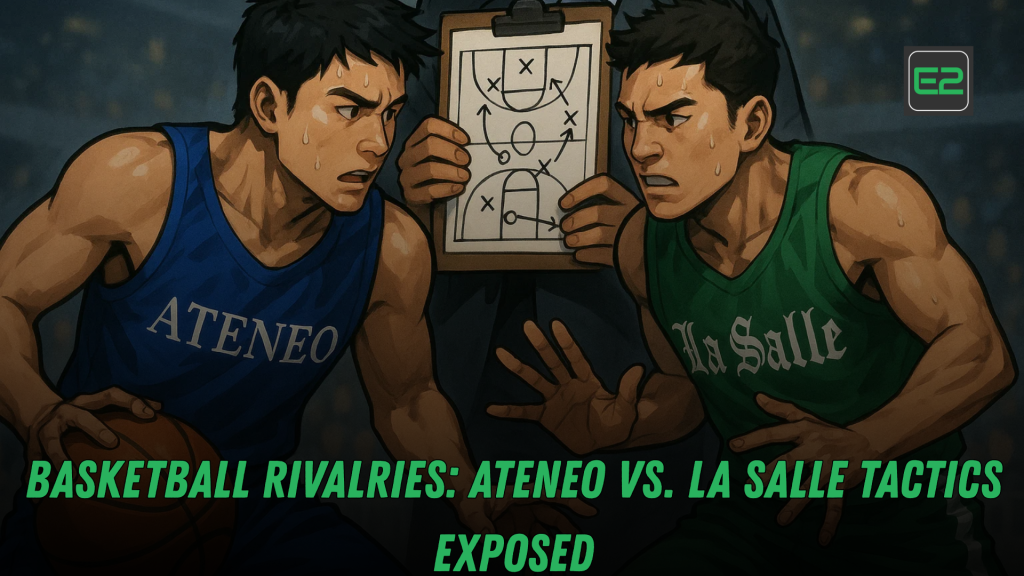Table of Contents
Why This Rivalry Feels Different
In the Philippines, a basketball game can be part sporting event, part cultural festival, and part midterm exam. Few fixtures embody that more than Ateneo vs. La Salle. Beyond alumni hashtags and thundersticks, this rivalry delivers a tactical duel that coaches replay in film rooms for years. What separates these contests isn’t just talent—it’s system vs. system, principle vs. principle, and adjustment vs. adjustment over forty pressure-packed minutes.
This guide pulls the curtains on the most consistent strategic themes across coaching eras and roster cycles. You’ll learn how each side builds shot quality, protects the paint, manages pace, and wins the math game with fouls, free throws, and rebounding. We’ll map common actions (Spain PnR, horns, pistol), typical coverages (ICE, switch, scram), signature presses (1-2-2, run-and-jump), and the subtle off-ball tricks that swing a quarter. Finally, we give you a fan’s checklist—what to watch on the next tip-off so you can call the counters before they happen.

Part I — Rivalry DNA: Eras, Identities, and the Big Rock Principles
Ateneo’s Core Identity
Across eras, Ateneo’s best teams share three traits:
- Shot selection discipline — threes at the line and at the rim, mid-range only by design.
- Flow offense — a blend of 5-out motion, continuity ball screens, DHOs, and selective Spain pick-and-roll to force multiple efforts on defense.
- No-middle defense — the lane is a red zone, with gap help, low man readiness, and scram switches to protect mismatches without constant double teams.
La Salle’s Core Identity
La Salle’s top vintages tend to embody:
- Pressure and pace — from 1-2-2 or 2-2-1 containment to run-and-jump, exporting turnovers into layups and foul pressure.
- Rim pressure & rebounding — bully-ball drives, duck-ins, and a ferocious offensive glass that converts misses into free points.
- Simple actions, violent cuts — pistol, horns, and flex-style wrinkles executed with muscle memory and vertical spacing (dunker spot activity).
Rivalry constant: Ateneo wants to make it a half-court decision game; La Salle wants possessions to snowball via turnovers, second chances, and foul count leverage. Each seeks to drag the other out of comfort.
Part II — Ateneo’s Offense: How the Blue Eagles Build Advantage
2.1 5-Out Motion and Continuity Ball Screen
Ateneo uses a 5-out shell to remove rim protectors from the paint and widen driving lanes. Expect:
- Slot DHOs (wing to slot) that flow into keeper drives or re-screen actions.
- Empty-corner PnR to eliminate the strong-side tagger and isolate the low man.
- Lift and shake principles: when the ball drives baseline, the weak-side wing lifts and the corner shakes up to create a natural passing window.
Why it works: The defense must make multiple closeouts. Each closeout is a chance to attack the top foot, draw a second defender, or hit the spray-out three.
2.2 Spain Pick-and-Roll (Back-Screen the Roller)
A classic Ateneo “dagger” at key moments:
- Ball-handler and screener run middle PnR.
- A third offensive player back-screens the rolling big’s defender (who often steps up to contain).
- Counters: short roll vs switch; ghost screen vs pre-switch; slip if the back-screener’s defender top-locks.
Scouting cue for fans: Watch the defender guarding the back-screener—if he pre-switches early, Ateneo flips into ghost-Spain (fake the back-screen, slip to three).
2.3 Ghost Screens, Veers, and Angle Changes
The Blue Eagles excel at disguising contact—fake screens that become pop threes or veers into a secondary pick, transforming a basic action into a defense’s worst nightmare: late communication.
2.4 Post Seals from the Slot
Rather than old-school block post-ups, expect cross-screen into slot seal—big catches at 10–12 feet, facing up. The spacing preserves skip passes to shooters if the help collapses.
Part III — La Salle’s Offense: Pressure the Rim, Break the Glass, Punish Rotations
3.1 Pistol Series (Hand-off + Ball Screen on the Wing)
La Salle loves to turn a simple pitch-ahead into instant offense:
- Guard dribbles to wing, hands off to a second guard cutting up.
- A trailing big sets a wing ball screen for that cutter.
- Strong-side corner lifts to complicate help responsibility.
Layering: If the initial drive is cut off, La Salle flows to veer screen (big flips angle), then pocket pass or skip to corner.
3.2 Horns (Two Bigs Up Top)
La Salle uses horns double (screens on both sides) to force defensive coverage calls:
- Horns flare: one big flares to the wing for a quick catch-and-drive.
- Horns high-low: if Ateneo switches, expect a seal inside on the smaller defender.
- Horns flex: back-screen on the box, then a down-screen to free an elbow jumper or cut.
3.3 Duck-Ins and Dunker Spot Timing
When the ball drives, watch La Salle’s dunker spot (short corner). The big drifts with the driver’s vision for drop-offs or reverse-pivot seals. Misses are second-chance fuel—a signature edge.
3.4 Drive-First Philosophy
La Salle attacks hips and gaps—not just plays. The goal: two feet in the paint before the second pass. That means free throws, kick-outs, and backbreaking put-backs.
Part IV — Ateneo’s Defense: No-Middle, ICE, and Scram
4.1 No-Middle and Gap Help
Ateneo shows the ball to the sideline and baseline, rarely allowing clean middle drives. Help sits in the gaps; nail defenders deter slot penetration. The low man tags rollers on time and recovers by rule.
4.2 Ball Screen Menu
- ICE on side PnR: keep the ball on the side, big drops to contain; prevent middle.
- Switch 1–4 vs equal size lineups; peel switch if beaten.
- Scram switch: when a small is stuck on a big inside, a weak-side defender pre-rotates to swap the small out before the entry arrives.
4.3 Rotational Integrity
A hallmark: rotating one pass away only when the ball leaves the handler’s hands. That removes free rim cuts and keeps closeouts balanced.
Part V — La Salle’s Defense: Pressures, Traps, and Mix-Up Menus
5.1 Press Packages: 1-2-2, 2-2-1, Run-and-Jump
La Salle stretches the floor with containment presses that morph into traps on the sideline:
- 1-2-2 soft: bleed clock, force sideline.
- 2-2-1: bait the middle then spring trap after the first pass.
- Run-and-jump: surprise switch/attack the dribbler after a pass back, creating controlled chaos.
Goal: shorten Ateneo’s half-court clock and generate live-ball turnovers.
5.2 Half-Court Coverage
Primarily man-to-man with physical chest-up drives and top-locks vs shooters trying to use pin-downs. Expect zone pockets after timeouts to disrupt rhythm, e.g., 2-3 match-up for two possessions.
5.3 Special Defenses
In high-leverage moments, La Salle won’t hesitate to deploy box-and-one or triangle-and-two vs star scorers—especially after a hot quarter—to force secondary creators to beat them.
Part VI — The Chess Match: Who Controls Pace and the Math?
6.1 Pace & Possessions
- Ateneo key: keep turnovers under 12, force La Salle into half-court.
- La Salle key: win turnover margin and offensive rebound rate; even a cold shooting night becomes survivable with +10 attempts.

6.2 Foul Count & Free Throws
La Salle’s rim pressure often tilts whistle patterns. Ateneo counters by verticality at the rim and making early low man tags to avoid reaching fouls. Track team fouls each quarter—foul bonus timing decides tempo.
6.3 Shot Profile
- Ateneo: rim + corner threes; mid-range mostly late clock or post-fades vs mismatch.
- La Salle: rim, free throws, short-corner floaters; threes off drive-kick and skip when help collapses.
Part VII — Special Situations: Where Games Swing
7.1 ATOs (After-Timeout)
- Ateneo: Spain PnR variants, blind pig back-cuts from elbow entries, SLOB hammer (baseline flare + weak-side corner 3).
- La Salle: Horns high-low, pistol hand-back into ghost, stack inbound for lob or quick seal.
7.2 Two-for-One and End-Game
- Ateneo: clean two-for-one math—early empty-side PnR with a quick pull-up, trust defense.
- La Salle: push-ahead drag screen for early rim touch; if leading, bleed clock then high-low to bury a dagger.
7.3 SLOB/BLOB Catalog
- Stack, box, diamond entries; Ateneo leans on misdirection flares, La Salle on rim seals. Watch bench cues—coaches call packages by hand signals; veterans read them like sheet music.
Part VIII — Player Archetypes: How Roles Shape Tactics
8.1 Ateneo Archetypes
- Big wing initiator: 6’3”–6’6”, guards multiple spots, triggers DHOs, punishes switches in the slot.
- Stretch-4 connector: short roll passer, corner spacer, back-screen technician in Spain actions.
- Ball-screen point guard: change-of-pace dribbler, great at snake dribbles and pocket passes.
- Switchable 5: mobile rim protector, deep seals on short clocks, high +IQ for scram calls.
- 3-and-D role wing: top-lock counter cutter, 45-cut savant.
8.2 La Salle Archetypes
- Bulldozer slasher: downhill torque, foul magnet, lives in the paint.
- Rim runner/put-back king: screen-sprint-seal habits, elite second-jump.
- Stretch big with bite: punishes drop coverage, drags bigs out of lane to open drives.
- Point of attack pest: picks up 94 feet, triggers run-and-jump calls.
- Dunker-spot ninja: baseline patience, reverse pivot seals, short-corner touch.
Part IX — Counters & Adjustments: If They Do X, You Do Y
9.1 If Ateneo Runs Spain PnR…
- La Salle counters: Pre-switch the back-screen; weak-side stunt from the corner then fly by; on a switch, scram early to remove the guard from a big.
- Ateneo re-counter: Ghost-Spain (fake back-screen; shooter pops), short roll to the nail for 4-on-3 reads, hammer weak-side to punish the stunt.
9.2 If La Salle Presses 1-2-2…
- Ateneo counters: 1–3–1 press break with a middle flash to the logo; pass not dribble; diagonal skip to opposite wing, finish with 2-on-1.
- La Salle re-counter: Run-and-jump on the re-entry pass; trap on the sideline after a speed-dribble.
9.3 If Ateneo ICEs Side PnR…
- La Salle counters: Reject the screen baseline, DHO re-screen to change angle, hit short corner if the low man tags too early.
- Ateneo re-counter: “Weak” coverage (force to off-hand), late switch to kill reject, corner X-out to protect three.
9.4 If La Salle Overloads the Glass…
- Ateneo counters: Push on the catch (rebounder becomes ball-handler), rim-run the 5 to force defensive matchups cross-grained, and hunt early threes vs cross-matches.
- La Salle re-counter: Pull one crasher back to the nail for early walling; foul at half-court to stop numbers if under the limit.
Part X — Practice Habits & KPIs: How Good Teams Prepare for Each Other
Drills that matter:
- 3-man chase into 4-on-3 (simulate press break outcomes).
- Nail and low-man tags with X-out closeout patterns.
- 45-cut and drift-lift timing vs drives.
- Scram switch calls off post entries.
- Free-throw boxouts (rivalry games are decided on extra points).
KPIs to watch:
- Turnovers ≤ 12 (Ateneo target), offensive rebound rate ≥ 35% (La Salle target).
- Paint touches per quarter; foul bonus timing (who reaches 5 first).
- Corner 3 attempts (Ateneo) vs second-chance points (La Salle).
- ATO conversion rate; two-for-one execution in Q2 and Q4.
Part XI — Recruitment Pipelines and Player Development
- Ateneo: long runway guards/wings with processing speed—players who read second-side actions, make spray-outs, and survive switches defensively. Development is conceptual: teach reads, not plays.
- La Salle: dynamic athletes who pressure the rim, rebound out of area, and defend the ball for 94 feet. Development is habit-first: sprint screens, crackback boxouts, early help rotation.
Both programs win when they recruit motor + feel. Motor without feel loses late; feel without motor gets run over.
Part XII — For Fans: What to Watch in Real Time
- First 5 minutes: Is La Salle’s press forcing loopy passes? Is Ateneo getting to the nail?
- Middle 10: Who controls the offensive glass? Are corner threes open or taken away?
- Last 5: Does Ateneo go to Spain PnR? Does La Salle toggle to box-and-one? Track timeouts—ATO plays decide games.
Part XIII — The Emotional Edge: Confidence vs. Composure
Rivalry noise tests composure. Ateneo’s advantage is possession-by-possession stoicism; La Salle’s edge is surge energy off a press steal or and-1. Momentum swings are common—what matters is who can break runs with a paint touch or grind a stop without fouling.
Conclusion: Strategy Makes the Spectacle
Ateneo–La Salle isn’t just blue vs green—it’s ideology vs ideology. One side bends you with spacing and reads; the other breaks you with pressure and force. Both models win when executed faithfully. And in the margins—ATO wizardry, rebounding wars, foul math—the rivalry renews its mystique.
If you love the fireworks, you’ll love the framework behind them. The next time these programs collide, keep this guide handy and call the counters before they happen.

Strong Call-to-Action (CTA)
Want a printable game-watching checklist, plus animated breakdowns of Spain PnR, horns high-low, and 1-2-2 press traps? Tell me which team you support and your favorite era. I’ll send a one-page cheat sheet, three 30-second clip notes, and a fan KPI tracker so your next viewing party feels like sitting on the bench with the coaches.
Frequently Asked Questions (FAQ)
1) What is the single biggest tactical battle in Ateneo vs La Salle?
Pace vs. precision. La Salle seeks chaos through pressing and offensive rebounding; Ateneo seeks control via no-middle rules and flow offense. Whoever imposes their operating tempo usually wins the shot-quality war.
2) Why does Ateneo use Spain pick-and-roll in clutch moments?
Spain PnR creates double-help dilemmas—the roller’s defender is back-screened, forcing rotations that open short rolls, corner threes, or deep seals. It’s a clean, rehearsed way to manufacture a high-value look under pressure.
3) How does La Salle’s 1-2-2 differ from a pure trap press?
The base 1-2-2 is containment—it bleeds clock and steers the ball to the sideline. La Salle toggles into selective traps after a bad angle pass or a dead-ball inbound, then rotates behind to hunt live-ball turnovers.
4) Which advanced stats should fans track?
Turnover % (Ateneo ≤ 17% of possessions)
O-reb% (La Salle ≥ 35%)
FTR (free-throw rate—who wins the whistle)
Corner 3 attempts vs paint points — a proxy for spacing vs force battles.
5) If I’m coaching youth inspired by this rivalry, what should I teach first?
Teach spacing, two-foot finishes, and help rules (nail, low man, X-out). Add one press (1-2-2 contain) and one late-game set (Spain PnR or horns high-low). Keep concepts simple; master the reads before adding plays.
